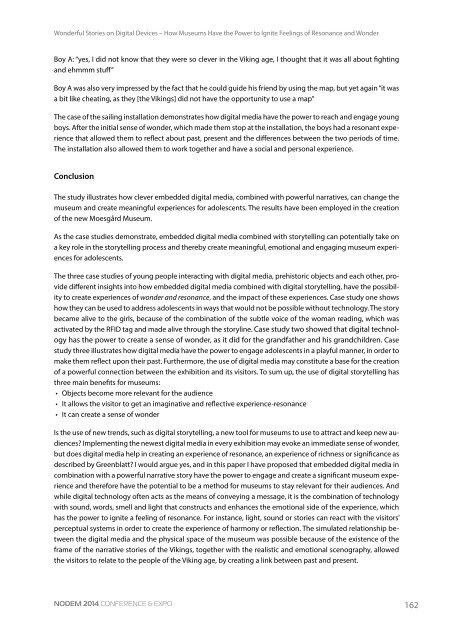NODEM 2014 Proceedings
NODEM 2014 Proceedings
NODEM 2014 Proceedings
Create successful ePaper yourself
Turn your PDF publications into a flip-book with our unique Google optimized e-Paper software.
Wonderful Stories on Digital Devices – How Museums Have the Power to Ignite Feelings of Resonance and Wonder<br />
Boy A: “yes, I did not know that they were so clever in the Viking age, I thought that it was all about fighting<br />
and ehmmm stuff”<br />
Boy A was also very impressed by the fact that he could guide his friend by using the map, but yet again “it was<br />
a bit like cheating, as they [the Vikings] did not have the opportunity to use a map”<br />
The case of the sailing installation demonstrates how digital media have the power to reach and engage young<br />
boys. After the initial sense of wonder, which made them stop at the installation, the boys had a resonant experience<br />
that allowed them to reflect about past, present and the differences between the two periods of time.<br />
The installation also allowed them to work together and have a social and personal experience.<br />
Conclusion<br />
The study illustrates how clever embedded digital media, combined with powerful narratives, can change the<br />
museum and create meaningful experiences for adolescents. The results have been employed in the creation<br />
of the new Moesgård Museum.<br />
As the case studies demonstrate, embedded digital media combined with storytelling can potentially take on<br />
a key role in the storytelling process and thereby create meaningful, emotional and engaging museum experiences<br />
for adolescents.<br />
The three case studies of young people interacting with digital media, prehistoric objects and each other, provide<br />
different insights into how embedded digital media combined with digital storytelling, have the possibility<br />
to create experiences of wonder and resonance, and the impact of these experiences. Case study one shows<br />
how they can be used to address adolescents in ways that would not be possible without technology. The story<br />
became alive to the girls, because of the combination of the subtle voice of the woman reading, which was<br />
activated by the RFID tag and made alive through the storyline. Case study two showed that digital technology<br />
has the power to create a sense of wonder, as it did for the grandfather and his grandchildren. Case<br />
study three illustrates how digital media have the power to engage adolescents in a playful manner, in order to<br />
make them reflect upon their past. Furthermore, the use of digital media may constitute a base for the creation<br />
of a powerful connection between the exhibition and its visitors. To sum up, the use of digital storytelling has<br />
three main benefits for museums:<br />
• Objects become more relevant for the audience<br />
• It allows the visitor to get an imaginative and reflective experience-resonance<br />
• It can create a sense of wonder<br />
Is the use of new trends, such as digital storytelling, a new tool for museums to use to attract and keep new audiences?<br />
Implementing the newest digital media in every exhibition may evoke an immediate sense of wonder,<br />
but does digital media help in creating an experience of resonance, an experience of richness or significance as<br />
described by Greenblatt? I would argue yes, and in this paper I have proposed that embedded digital media in<br />
combination with a powerful narrative story have the power to engage and create a significant museum experience<br />
and therefore have the potential to be a method for museums to stay relevant for their audiences. And<br />
while digital technology often acts as the means of conveying a message, it is the combination of technology<br />
with sound, words, smell and light that constructs and enhances the emotional side of the experience, which<br />
has the power to ignite a feeling of resonance. For instance, light, sound or stories can react with the visitors’<br />
perceptual systems in order to create the experience of harmony or reflection. The simulated relationship between<br />
the digital media and the physical space of the museum was possible because of the existence of the<br />
frame of the narrative stories of the Vikings, together with the realistic and emotional scenography, allowed<br />
the visitors to relate to the people of the Viking age, by creating a link between past and present.<br />
<strong>NODEM</strong> <strong>2014</strong> Conference & Expo<br />
162


